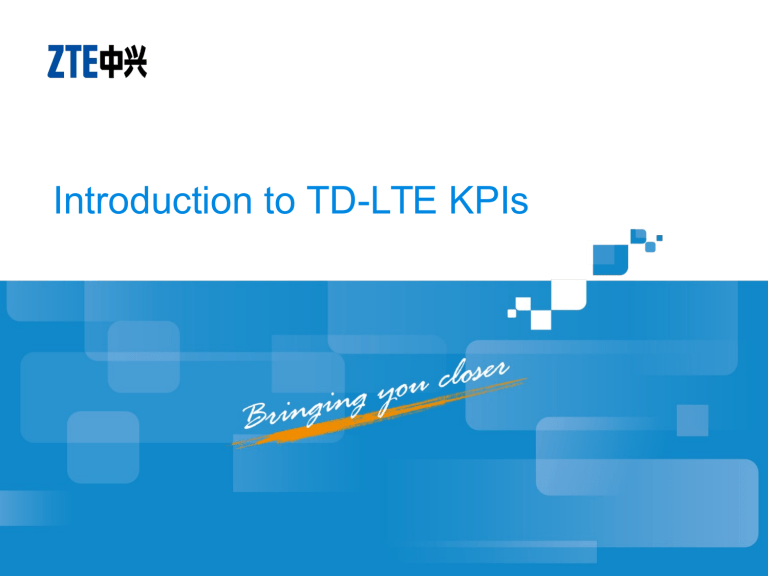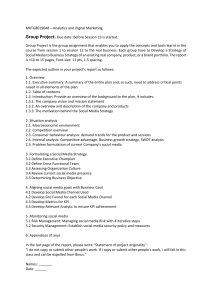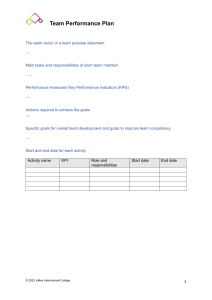
Introduction to TD-LTE KPIs Contents Overview of Key Performance Indicators (KPIs) KPI Establishment KPI Report Procedure KPI Classification KPI Analysis KPI Overview Definition: The definitions of Key Performance Indicator (KPI) vary by industries. KPIs are important criteria used to evaluate the operation of wireless networks, for example, wireless call completion rate and wireless call drop rate. A KPI is a value calculated through a series of PIs or counters. KPIs reflect the network running status. Therefore, KPI values are objective criteria and important basis for evaluating network running status and quality. KPI Related Concepts PI Although Performance Indicator (PI) as a type of Measure of Performance is less critical than the KPI, yet it is still used as a reference data to evaluate the network operation. PI values are obtained through corresponding counters. Counter Each count corresponds to a counter, and there are thousands of counters in a system. Northbound Counter The counter value reported according to the northbound Operation Management Center (OMC) requirements is computed and reported by a local counter. Northbound OMC uses these counters to compute KPI values. Relationship Among KPIs, PIs, Counters, and Northbound Counters (1) All KPIs, PIs, and northbound counters are computed through original counters, and the corresponding formula are clearly defined in related standards of ZTE. The correctness of original counters and formulas is a prerequisite for accurate KPI results. Counter calculate calculate North Counter calculate PI KPI Relationship Among KPIs, PIs, Counters, and Northbound Counters (2) Counters --- Vegetables All KPIs and PIs need to use counters as raw materials for processing and production. Northbound Counters --- Semi-finished Dishes Counters reported to northbound counters must be reprocessed by northbound counters before they become KPIs. Relationship Among KPIs, PIs, Counters, and Northbound Counters (3) PIs---Appetizers KPIs---Main Courses 7 Although a PI is more often than not ignored, yet it has the potential to become a KPI. KPIs are indicators that attract the most attention, and they are the main course that makes or breaks a meal. Contents Overview of KPIs KPI Establishment KPI Report Procedure KPI Classification KPI Analysis KPI Establishment (1) Take the call drop rate of TD-SCDMA video service as an example to explain the establishment process of a KPI: For this KPI, the computing formula extracted from the northbound OMC is as follows: (RAB.RelReqCSperTraffic.Conv.<5><5>+IU.NbrRABCSRelIuConn perTraffic.Conv.<5><5>)/(RAB. SuccEstabCSNoQueuing. Conv.<5><5>+RAB.SuccEstabCSQueuing.Conv.<5><5>) This KPI is calculated by using four northbound counters obtained through counters, as shown below: RAB.RelReqCSperTraffic.Conv.<5><5>=C350131088 IU.NbrRABCSRelIuConnperTraffic.Conv.<5><5>=C350131279 RAB. SuccEstabCSNoQueuing. Conv.<5><5>=C350100042 RAB.SuccEstabCSQueuing.Conv.<5><5>=C350100137 KPI Establishment (2) For this KPI, the computing formula extracted from the OMC is as follows: (C350131088 + C350131279) / (C350100042 + C350100137) ZTE defines the preceding formula as follows: (Number of RABs that are released by RNC request for CS domain and segmented based on service rates + Number of RABs that are released by RNC request for CS domain and correspond to lu) / Number of successful RAB establishments without queuing for CS domain + Number of successful RAB establishments with queuing for CS domain) “TD-SCDMA video service call drop rate” is calculated by using the four counters. Then how are these counter values determined? How does the system gather statistics of these values? Isn’t it clear to explain it in this way? How to Determine Counter Values? The following questions arise as the entire system has thousands of original counters: Where do counter values come from? How to ensure the consistency between counters and actual calls? How to determine the correctness of the counters? How to distinguish so many types of counters? Counters are provided according to the signaling statistics in call flow. RRC connection request counts RRC connection setup success counts Contents Overview of KPIs KPI Establishment KPI Report Procedure KPI Classification KPI Analysis KPI Report Procedure 1 As there are many different types of counters, the foreground does not need to submit all counter values while computing a KPI. Use measurement task to control what data needs to be reported; The reported data needs to feedback to the specific level of OMC from which a measurement task is delivered. Northbound OMC Measurement task is an activity which allows users to define which performance data needs to be collected. Then foreground equipment system will collect performance data according to measurement task, and the OMC will store the collected performance data. OMC ( MINOS ) OMM eNodeB KPI Report Procedure 2 Delivering measurement tasks is like growing vegetables on the RNC PI Return counter values KPI Counte r Northboun d counter Compute PI and KPI Reported to northbound counter KPI Report Procedure 3 Northbound OMC needs to use counter (RAB.RelReqCSperTraffic.Conv.<5><5>) to deliver RAB measurement cluster. RAB.RelReqCSperTraffic.Conv.<5><5>=C350131088 OMC needs to use counter (C350131088) to deliver RAB release request statistics. Measurement Objects and Measurement Types A measurement task needs to specify what and how to measure, so it is extremely important to manage counters. Measurement objects include: RncFunction, IubLink, UtranCell, Carrier, UtranRelation, GsmRelation, IucsLinkRnc, and IupsLinkRnc. Measurement types: A measurement type Indicate a collection of the same type of counters. To well manage counters, some related counters are categorized into one measurement type in the system. Contents Overview of KPIs KPI Establishment KPI Report Procedure KPI Classification KPI Analysis KPI Specifications There are many KPIs to measure the performance of a network. Operators defines what KPIs each manufacturer must provide, and standardizes algorithms. KPIs may constantly change. Classification of KPIs The TD-LTE KPIs defined currently can be divided into several categories, and each category consists of lots of KPIs. KPI Category Related KPIs Coverage RSRP, RS-CINR, and coverage. Call Establishment RRC connection success rate, E-RAB establishment success rate, wireless call completion rate, and E-RAB establishment contestation rate. Call Hold RRC connection call drop rate and E-RAB call drop rate. Mobility Management Intra-eNodeB handover success rate, X2 interface handover success rate, S1 interface handover success rate, and intersystem handover success rate (handover among GSM, WCDMA, TD, and CDMA). Quality Uplink and downlink block error rate and uplink and downlink MAC layer retransmission rate. System Resource traffic index and radio resource utilization indexes. Contents Overview of KPIs KPI Establishment KPI Report Procedure KPI Classification KPI Analysis Coverage Indexes Call Setup Indexes Call Retention Indexes Mobility Management Indexes Quality Indexes System Resource Indexes RSRP RSRP indicates an absolute value of received signal strength. To some extent, it can reflect distance between UEs and eNodeBs. Therefore, this KPI value can measure the cell coverage. RSRP is defined as the linear average over the power contributions of the resource elements (RE) that carry cell-specific reference signals (RS) within the considered measurement frequency bandwidth. Assume RSRP threshold is A, then RSRP coverage index (percentage) = The number of test point with RSRP≥A/Total number of drive test points . Before computing the RSRP, exclude abnormal test points whose RSRP value is far beyond the normal value. Within coverage areas, the TD-LTE network coverage must have a more than 95% probability of RSRP > -105dBm. When a test antenna is put on car roof, there must be a more than 95% probability of RSRP> - 95dBm. RS-CINR RS-CINR indicates carrier-to-interference ratio on RS channel measured by UE. It is one of the key indexes to indicate channel quality. Carrier to Interference plus Noise Ratio (CINR) is the ratio of carrier to the noise and interference, which is measured by UE in drive test. In the emulation tool CNP, RS-CINR=serving cell RSRP /(neighbor cell RSRP+N); where, N is the thermal noise power. Within coverage areas, the TD-LTE network coverage must have a more than 95% probability of RS-CINR >0dB. PDCCH SINR PDCCH SINR indicates the quality of PDCCH. Formula: PDCCH SINR = (PDCCH receive power of the best serving cell/ PDCCH interference in the cell). The quality requirement of PDCCH can be met if PDCCH SINR>-1.6dB. Coverage Wireless network coverage reflects the availability of a network. RSRPR, and RSRQ S, where: RSRP indicates downlink reference signal received power; RSRQ indicates the signal quality of received reference signal; R and S indicate RSRP and RSRQ thresholds. Before calculation, exclude abnormal tested points whose RSRP value or RSRQ value is far beyond the normal value. Within coverage areas, the TD-LTE network coverage must have a more than 95% probability of RSRP -105dBm, and RSRQ > -13.8dB. Contents KPI Overview KPI Establishment KPI Report Procedure Index Classification Key Index Analysis Coverage Indexes Call Setup Indexes Call Retention Indexes Mobility Management Indexes Quality Indexes System Resource Indexes Call KPIs Call success rate is one of the most important KPIs that reflect LTE system performance and attract operators’ attention. A complete call completion rate includes: Paging success rate, RRC connection setup rate, and E-RAB assignment setup success rate. RRC connection setup The mobileoriginated process does not include paging; After E-RAB assignment succeeds, UE can use data services such as webpage browsing and FTP downloading. E-RAB assignment setup RRC Connection Setup Success Rate This index indicates the capacity of an eNodeBs or a cell to admit UEs. RRC Connection setup success means that there is a signaling connection between a UE and the network. After receiving a UE RRC Connection request, the eNodeB decides whether to set up an RRC Connection for the UE. Service-dependent There are two types of RRC connection setup Service-independent The mobile-originated and mobileterminated calls Emergency calls, and inter-system cell update and registration RRC connection setup success rate = Number of RRC connection setup successes/RRC connection setup attempts × 100%. RRC Connection request attempts RRC Connection setup complete 1. There are corresponding counters in place between two signaling points to collect the number of RRC connection request attempts. 2. When calculating service-dependent RRC connection setup success rate, collect statistics of only the number of service-dependent RRC connection setup successes. E-RAB Connection Setup Success Rate E-RAB connection is used to transfer voice, data and multmedia services between UEs and CN. E-RAB connection setup success rate reflects the capacity of an eNodeB or a cell to admit services. E-RAB setup is initiated by the CN. A basic service is set up after ERAB connection is established. E-RAB setup is implemented in the following two scenarios: When an eNodeB sets up the initial context for UE. When an MME initiates an E-RAB Setup Request (bearer setup) E-RAB setup success rate = (Number of E-RAB setup successes (all QCIs) /Number of E-RAB setup requests (all QCIs)) * 100% E-RAB Setup in Initial Context Setup Procedure E-RAB Connection Setup Request E-RAB Connection Setup Response The message that contains the number of ERAB setup requests: INITIAL CONTEXT SETUP REQUEST The message that contains the number of ERAB setup successes: INITIAL CONTEXT SETUP RESPONSE MME-Initiated E-RAB Setup The message that contains the number of E-RAB setup requests: E-RAB SETUP REQUEST The message that contains the number of E-RAB setup successes: E-RAB SETUP RESPONSE E-RAB Setup Request E-RAB Setup Success Radio Call Completion Rate This index reflects the capability a cell has to admit UE-originated calls, which directly affects user network experience. Radio call completion rate = E-RAB setup success rate RRC connection setup success rate (service-related) 100% E-RAB Setup Blocking Rate This index only reflects E-RAB setup failures caused by the system capacity, namely, the E-RAB setup failure with cause value of radio resources not available. E-RAB blocking rate = Number of E-RABs that the MME refuses to admit /Number of E-RABs for which the eNodeB requests an admission × 100%. Signaling points used to collect statistical information are as follows: (a) Failure to set up initial context (b) E-RAB setup failure occurring when radio resources are not available Number of E-RABs admitted Number of E-RABs admitted Number of E-RABs rejected Number of E-RABs rejected Contents KPI Overview KPI Establishment KPI Report Procedure Index Classification Key Index Analysis Coverage Indexes Call Setup Indexes Call Retention Indexes Mobility Management Indexes Quality Indexes System Resource Indexes Call Drop Rate for RRC Connection Exceptions UE RRC connections may be released due to an eNodeB exception. This probability indicates the RRC connection retention performance of an eNodeB and reflects user network experience to some extent. Call drop rate for RRC connection exceptions = Number of RRC connection releases due to an exception/(RRC connection success count + RRC reconnection success count) × 100% The number of RRC connection releases due to an exception refers to the number of all improper RRC connection releases. RRC connections can be properly released when the core network properly releases RRC connections, actively initiates the LOADBALANCE release, and initiates a RESET message. The RRC Connection Release message carries the cause. 3GPP TS 36.331 defines the cause as the load balance or others. Radio Interface Bearer Release – Normal Procedure 1 E-RAB Release(by MME)with UecontextRelease Command : Sampling Point 1: The eNodeB receives the UE CONTEXT RELEASE COMMAND message from the MME. Sampling Point 2: The eNodeB sends the RRC CONNECTION RELEASE message to the UE. Sampling Point 3: The eNodeB sends the UE CONTEXT RELEASE COMPLETE message to the MME. Radio Interface Bearer Release – Normal Procedure 2 Normal procedure: OMC signaling Radio Interface Bearer Release – Normal Procedure 3 E-RAB Release(by MME)with S1 reset : Sampling Point 1: The eNodeB receives the RESET message from the MME. Sampling Point 2: The eNodeB sends the RESET ACKNOWLEDGE message to the MME. Sampling Point 3: The eNodeB sends the RRC CONNECTION RELEASE message to the UE. Radio Interface Bearer Release – Normal Procedure 4 Normal procedure: OMC signaling E-RAB Call Drop Rate Generally, the eNodeB initiates a request to the MME for releasing one or multiple E-RABs when any exception occurs. In the case of UE losses, UE deactivations, or eNodeB exceptions, the eNodeB sends a request to the MME for releasing the UE context. This may cause the MME to release all setup E-RABs as well. The E-RAB call drop rate relates to the number of eNodeB-initiated E-RAB release requests not due to UE inactivation and the number of E-RABs released due to UE context release initiated by eNodeB exceptions. E-RAB call drop rate = (Number of service-based E-RABs (all QCIs) for which the eNodeB sends a release request – Number of E-RABs (all QCIs) for which the eNodeB sends a release request due to UE inactivation/Number of successfully set up service-based E-RABs (all QCIs) + Number of cells that hand over to the E-RAB (all QCIs) – Number of cells that hand over from the E-RAB (all QCIs) × 100% Contents KPI Overview KPI Establishment KPI Report Procedure Index Classification Key Index Analysis Coverage Indexes Call Setup Indexes Call Retention Indexes Mobility Management Indexes Quality Indexes System Resource Indexes TD-LTE Handover LTE networks support manual handover only. UEs have to disconnect the links with their serving cells and then get admitted to the target cells. LTE systems support intra-system and inter-system handovers. Intra-system handovers can be classified into intra-frequency and inter-frequency handovers according to carrier configuration conditions. Inter-system handovers support the handover between all systems, for example 2G, 3G (CDMA, WCDMA, and TD-SCDMA) . LTE handovers only include hard handovers. All UEs are admitted to a specific target cell after disconnecting serving cell communication links. Handover Trigger Causes Network coverage trigger Network load trigger Speed trigger Service trigger The quality of neighboring cell signals is superior than that of serving cell signals. Moreover, the servicing cell signal quality falls below a specific threshold. Serving cells are overloaded. Neighboring cells bear few loads. The neighboring cell quality detected by the UE satisfies a specific threshold. When the eNodeB judges that the UE moves at a speed higher or lower than a specific speed and the network where the UE camps on is deployed with high-speed and lowspeed cells, the eNodeB hands over the UE to a corresponding cell. A specific UE-initiated service is not supported by serving cells but supported by neighboring cells. The neighboring cell quality detected by the UE satisfies a specific threshold. Intra-eNodeB Handover Success Rate Intra-eNodeB handovers contain intra-frequency and inter-frequency handovers, both supporting incoming and outgoing handovers and requiring separate calculations of handover success rates. Success rate of intra-eNodeB intra-frequency incoming/outgoing handovers = Number of successful intra-eNodeB intra-frequency incoming/outgoing handovers/Number of requests for intra-eNodeB intra-frequency incoming/outgoing handovers Success rate of intra-eNodeB inter-frequency incoming/outgoing handovers = Number of successful intra-eNodeB inter-frequency incoming/outgoing handovers/Number of requests for intra-eNodeB inter-frequency incoming/outgoing handovers 100% Measurement-based and non-measurementbased handovers must be considered when you calculate handover counts. (1) Non-measurement-based handovers are triggered by judging load balance or more. (2) Measurement-based handovers are triggered by delivering measurement reports. X2 Handover Success Rate 1 This index reflects the success rate for a UE connected with multiple eNodeBs over the X2 interface to hand over from one eNodeB to another. It relates to the system handover processing capability and network optimization and is an important index affecting direct user experience. X2 handovers contain intra-frequency and inter-frequency handovers, both supporting incoming and outgoing handovers and requiring separate calculations of handover success rate. Success rate of intra-frequency X2 incoming/outgoing handovers = (Number of successful intra-frequency X2 incoming/outgoing handovers/Number of requests for intra-frequency X2 incoming/outgoing handovers) 100% Success rate of inter-frequency X2 incoming/outgoing handovers = (Number of successful inter-frequency X2 incoming/outgoing handovers/Number of requests for inter-frequency X2 incoming/outgoing handovers) 100% X2 Handover Procedure and Signaling Point Outgoing Statistics handover request Outgoing handover completed Incoming handover request Incoming handover completed S1 Handover Success Rate When the eNodeB decides to perform a UE handover based on UE measurement results and the target cell is not connected to this eNodeB over an X2 interface, hand over the UE over an S1 interface on the core network. This index relates to the system handover processing capability and network planning and is an important index affecting direct user experience. S1 handovers contain intra-frequency and inter-frequency handovers, both supporting incoming and outgoing handovers and requiring separate calculations. Success rate of intra-frequency S1 incoming/outgoing handovers = (Number of successful intra-frequency S1 incoming/outgoing handovers/Number of requests for intra-frequency S1 incoming/outgoing handovers) × 100% Success rate of inter-frequency S1 incoming/outgoing handovers = (Number of successful inter-frequency S1 incoming/outgoing handovers/Number of requests for inter-frequency S1 incoming/outgoing handovers) × 100% S1 Handover Procedure and Signaling Point Statistics Inter-System Handover Success Rate TD-LTE system may coexist with GSM, WCDMA, CDMA, and TD-SCDMA systems as a result of network construction. The handover from one system to another is called an inter-system handover. Incoming and outgoing handovers must be calculated. Inter-system handover success rates are given in a similar formula. The following equations take the cell handover between TD-LTE and CDMA as an example to calculate the success rate. Inter-system cell handover success rate (LTE-> CDMA) = Success rate of inter-system packet domain outgoing handovers (EPS-> CDMA) = (1 – Number of unsuccessful inter-system packet domain outgoing handovers (EPS-> CDMA)/Number of requests for inter-system packet domain outgoing handovers (EPS-> CDMA)) × 100 % Inter-system cell handover success rate (CDMA ->LTE) = Success rate of inter-system packet domain incoming handovers (CDMA ->EPS) = (Number of successful inter-system packet domain incoming handovers (CDMA ->EPS)/Number of requests for inter-system packet domain incoming handovers (CDMA ->EPS)) × 100 % Handover From LTE to Other Wireless Networks Inter-system packet domain outgoing handover request Handover From Other Wireless Networks to LTE Inter-system packet domain incoming handover request Handover completed Contents KPI Overview KPI Establishment KPI Report Procedure Index Classification Key Index Analysis Coverage Indexes Call Setup Indexes Call Retention Indexes Mobility Management Indexes Quality Indexes System Resource Indexes Uplink/Downlink Block Error Rate PUSCH (PDSCH) block error rates are an important index reflecting the wireless interface signal transmission quality, the basis for managing and controlling wireless resources, and a factor affecting system handover, power control admission, and other aspects. This index indicates network coverage conditions, reflects networking interference conditions, and is an index indirectly reflecting the network planning quality and algorithm-related quality. Uplink block error rate = (Number of CRC errors of received uplink transmission blocks/Number of received uplink transmission blocks in total) × 100% Downlink block error rate = (Number of CRC errors of received downlink transmission blocks/Number of received downlink transmission blocks in total) × 100% Uplink/Downlink MAC Layer Retransmission Rate Retransmission rate is a key ind reflecting the packet service quality and the HARQ performance. Improving retransmission rates is an important way to optimize packet service networks. You can calculate the uplink MAC layer retransmission rate by obtaining the confirmed number of MAC PDUs received by the eNodeB and the total number of received MAC PDUs. Uplink MAC layer retransmission rate = 1- Confirmed number of PDUs received in the uplink MAC layer/Number of PDUs received in the uplink MAC layer Downlink MAC layer retransmission rate = 1- Confirmed number of PDUs received in the downlink MAC layer/Number of PDUs received at the downlink MAC layer Contents KPI Overview KPI Establishment KPI Report Procedure Index Classification Key Index Analysis Coverage Indexes Call Setup Indexes Call Retention Indexes Mobility Management Indexes Quality Indexes System Resource Indexes Traffic Index—S1 Interface Traffic This index reflects system load conditions at S1s and facilities overall understanding of service usage conditions. It refers to the traffic calculated at the transport layer (IP layer) over S1s. As the uplink and downlink traffic volumes are symmetric, S1 traffic supports two indexes: S1 uplink (in relation to eNodeB) traffic and S1 downlink (in relation to eNodeB) traffic. S1 uplink traffic = Sum of data rates sent by all S1s and IP addresses to the IP layer S1 downlink traffic = Sum of data rates received by all S1s and IP addresses from the IP layer Unit: bit/s Traffic Index—X2 Traffic (Temporarily Unavailable) This index reflects system load conditions at X2s and refers to the traffic calculated the transport layer (IP layer) over X2s. As the uplink and downlink traffic volumes are symmetric, X2 traffic supports two indexes: X2 uplink (in relation to eNodeB) traffic and X2 downlink (in relation to eNodeB) traffic. X2 uplink traffic = Sum of data rates sent by all X2s and IP addresses to the IP layer X2 downlink traffic = Sum of data rates received by all X2s and IP addresses from the IP layer Unit: bit/s Traffic Index—Traffic at the MAC Layer This index reflects system load conditions at the MAC layer and indicates network load conditions as well as system processing capability to some extent. It is separately calculated based on uplink (UE--->eNodeB) and downlink (eNodeB-->UE) directions. Cell uplink traffic at the MAC layer = Data rates received at the MAC layer Cell downlink traffic at the MAC layer = Data rates sent from the MAC layer Data rates received at the MAC layer = Number of all PDUs received by the eNodeB in the uplink MAC layer from the UE Data rates sent from the MAC layer = Number of all PDUs sent by the eNodeB at the downlink MAC layer eNodeB uplink flow at the MAC layer = Sum of data rates received by all eNodeB cells at the MAC layer (temporarily unavailable) eNodeB downlink flow at the MAC layer = Sum of data rates sent by all eNodeB cells at the MAC layer (temporarily unavailable) Unit: Mbit/s Traffic Index—Traffic at the PDCP Layer This index reflects system load conditions at the PDCP layer and indicates network load conditions as well as system processing capability to some extent. It is separately calculated based on uplink (UE--->eNodeB) and downlink (eNodeB-->UE) directions. Cell uplink traffic (all QCIs) at the PDCP layer = Data rates received at the cell PDCP layer Cell downlink traffic (all QCIs) at the PDCP layer = Data rates sent from the cell PDCP layer eNodeB uplink flow at the PDCP layer = Sum of data rates received by all eNodeB cells at the PDCP layer (temporarily unavailable) eNodeB downlink flow at the PDCP layer = Sum of data rates sent by all eNodeB cells at the PDCP layer (temporarily unavailable) Unit: Mbit/s Average PUSCH PRB Utilization This index reflects radio resource utilization (in relation to PRBs assigned to the PUSCH) and provides the basis for optimizing system algorithms and deciding whether the system requires expansion. Average PUSH PRB utilization = Average value of utilization of all TTI PUSCH PRBs in a statistical cycle = Number of carrier-occupied PUSCH PRBs/Total number of cell-occupied PRBs in the uplink TTI PUSCH PRB utilization = Number of PUSCH PRBs occupied per TTI/ Total number of PUSCH PRBs per TTI Average PDSCH PRB Utilization This index indicates the utilization of PRBs assigned to the PDSCH. Average PDSH PRB utilization = Average value of utilization of all TTI PDSCH PRBs in a statistical cycle = Number of cell-occupied PRBs in the downlink/Total number of cell-occupied PRBs in the downlink TTI PDSCH PRB utilization = Number of PDSCH PRBs occupied per TTI/ Total number of PDSCH PRBs per TTI Average PRACH Resource Utilization This index reflects the system access capability and provides the basis for optimizing system parameters to some extent. Average PRACH resource utilization = Number of PRACH resources in use/Number of configured PRACH resources Namely, = Number of carrier-occupied PRACHs/Number of cell-occupied PRBs in the uplink PRACH resources are a collection of time domains, frequency domains, and code domains. The number of PRACH resources in use is the number of PRACHs which the eNodeB successfully resolves their preamble, including public and dedicated preambles. Maximum/Average Carrier Transmit Power Utilization (Temporarily Unavailable) By statistically obtaining the maximum and average carrier transmit power values allows you to estimate the maximum and average downlink system loads within a specific period, thereby knowing the carrier transmit power utilization within this period. During network planning, the system implements link budge calculation and capacity emulation according to preset downlink loads. Therefore, to calculate downlink carrier transmit utilization of each network cells has great significance in network expansion planning and network optimization. Maximum carrier transmit power utilization = Maximum carrier transmit power/Configured maximum carrier transmit power × 100% Average carrier transmit power utilization = Average carrier transmit power/Configured maximum carrier transmit power × 100% Paging Congestion Rate This user-perceptible index indirectly reflects radio paging channel utilization. It relates with paging message delivery failures due to eNodeB resource limitations. Paging congestion rate = Number of paging congestions/Number of paging attempts × 100% Where, Number of paging attempts = Number of paging congestions + Number of successful paging attempts (1) Number of paging congestions: refers to the number of paging failures. The eNodeB sends a paging message to the UE. The FP fails to add a paging record to the PCCH frame because paging occasions are full. (2) Number of successful paging attempts: The eNodeB receives the RRCConnectionSetupComplete message from the UE in response to the paging message.





